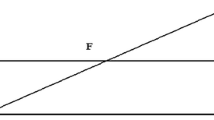Abstract
Many mathematics departments usually teach a variety of courses for students from different science departments and even from different faculties. These “service” courses are usually taught in the same way as the courses for mathematics major students. However, in science, because of the need to better analyse and interpret experimental data and the increased use of mathematical tools in chemistry and geology textbooks, it is becoming necessary to teach these science students quantitative skills beyond the scope of first year mathematics courses. This paper describes the design of a one-semester second year mathematics course, mainly for chemistry and geology students, with three specific objectives: to develop students’ ability to quantitatively analyse problems arising in their own field, to illustrate the great utility of mathematical models to provide answers to key chemistry and geology problems, to develop students’ appreciation of the diversity of mathematical approaches potentially useful in the chemical and geological sciences.
Similar content being viewed by others
References
Artigue, M.: 1999, ‘The teaching and learning of mathematics at the university level’, Notices of the AMS 46(11), 1377–1385.
Atkins, P. W.: 1998, Physical Chemistry, Oxford University Press, Oxford.
Boaler, J.: 1998, ‘Open and closed mathematics: Students’ experiences and understanding’, Journal for Research in Mathematics Education 29(1), 41–62.
Boggs, S. 1995, Principles of Sedimentology and Stratigraphy, Prentice Hall, New Jersey.
Cobb, G.W.: 1997, ‘Mathematics, statistics, and teaching’, The American Mathematical Monthly November 104(6), 801–823.
Evans, J.: 1999, ‘Building bridges: Reflections on the problem of transfer of learning in mathematics’, Educational Studies in Mathematics 39(1/3), 23–44.
Keller, K., Allen-King, R., O’Brien, R.: 2000, ‘A framework for integrating quantitative work into courses across the undergraduate geology curriculum’ Journal of Geoscience Education 48, 461–465.
Kolb, D.A.: 1984, Experiential Learning: Experience as the Source of Learning and Development, Prentice Hall, Englewood Cliffs, New Jersey.
Lutz, T. and Srogi, L.: 2000, ‘The role of a shadow course in improving the mathematics the mathematics skills of geoscience majors’, Journal of Geoscience Education 48, 476–480.
Macdonald, R.H. and Bailey, C.M.: 2000, ‘Integrating the teaching of quantitative skills across the geology curriculum in a department’, Journal of Geoscience Education 48, 482–486.
Masingila, J.O., Davidenko, S. and Prus-Wisniowska, E.: 1996, ‘Mathematics learning and practice in an out of school: A framework for connecting these experiences’, Educational Studies in Mathematics 31, 257–275.
McDermott, L.C. and Redish, E.F.: 1999, ‘Resources letter: PER-1: Physics education research’, American Journal of Physics 67(9), 755–767.
Paola, C. et al.: 2000, ‘ Geodynamics as the center of a new earth-sciences curriculum and the theme of a new undergraduate laboratory’, Journal of Geological Education 43, 485–491.
Schliemann, A.: 1995, ‘Some concerns about bringing everyday mathematics to mathematics education’, in L Meira and D. Carraher (eds.), Proceedings of the 19th International Conference for the Psychology of Mathematics Education (PME-15), Vol. III, Assisi, Italy, pp. 230–237.
Vacher, H.L.: 2000, ‘A course in geological-mathematical problem solving’, Journal of Geoscience Education 48, 478–481.
Verschaffel, L., Greer, B. and de Corte, E.: 2000, Making Sense of Word Problems, Lisse, Swets & Zeitlinger, The Netherlands.
Author information
Authors and Affiliations
Corresponding author
Rights and permissions
About this article
Cite this article
Witten, G.Q. Designing a Mathematics Course for Chemistry and Geology Students. Educ Stud Math 58, 1–19 (2005). https://doi.org/10.1007/s10649-005-2719-2
Issue Date:
DOI: https://doi.org/10.1007/s10649-005-2719-2




